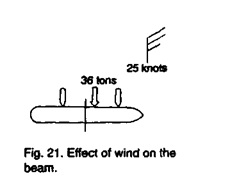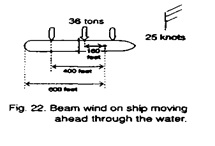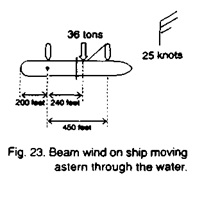Beam Wind
On the beam, the transverse wind-force of 25 knots exerts a force of 36 tons. The point of impact is forward of the midship because of the trim. Whether or not the tugs can keep the ship under control depends on the horsepower of the tugs and the side on which they are made fast.
Suppose that the ship is assisted by two tugs of 2,000 HP each, one tug forward, one aft. The bollard pull of the tugs is about 35 tons, but in backing they pull only about 13 tons. When the tugs are made fast on the starboard side, the combined force of the tugs can move the ship up against the wind. Backing on the port side, the tugs cannot hold the ship.
With the tugs on the port side, we need at least a strong tug forward. A tug of 4,000 HP, for instance, having bollard
pull of 65 tone and 29 tons on backing, could, in combination with the 2,000 HP tug aft, hold the ship, provided we prevent excessive dynamic loads on the tug’s headlines.
When the assisted ship is dead in the water and we have balanced the forces of wind and tugs, we have created a more or less static situation where the forward tug takes more of the load than the after tug.
Under forward motion (fig. 22), we have the rudder with sufficient leverage to correct any imbalance in forces. Let us assume that the point of impact of the wind-force is 40 feet forward of the midship and that the forward tug is made fast forward on the main deck, 150 feet from the stem; the after tug, aft on the main deck, 200 feet from the stern. Let us further assume that the pivot point under forward motion is about 200 feet from the stem, providing the rudder with a lever of 600 feet. As long as the forward tug can keep position, we can keep the ship under control.
Under stern motion (fig. 23), with the pivot point aft, 200 feet from the stern, we put a very heavy load on the forward tug. The rotational moment of the beam wind is then 8,640 feet/tons, which requires about a 20-ton pull of the forward tug to check, as the tug’s lever is about 450 feet.
Under lateral motion there will be an additional dynamic load on the tugs’ lines proportionate to the displacement of the ship and the ship’s lateral velocity.
A potential swing to starboard has to be anticipated by checking lateral motion all the time. Once a rotational motion is on, there is rotational momentum. With a ship of this size, the resulting load can vastly exceed the backing power of the forward tug and the breaking strength of its lines if the tug falls too heavily into them.
It can be seen that the tug is at an advantage when made fast as far forward as it can safely work.
In the situation described, there is little or no safety margin. We would not willingly take the ship in under this condition, particularly not with a current from aft; however, with a 20-knot wind, on coming in, a sudden increase in wind speed from 20 to 25 knots may occur when the ship is already committed to the berth.


Leave a Comment